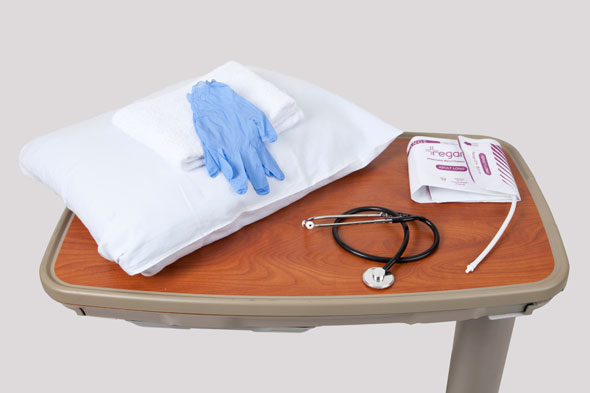Administering Intravenous Fluid Therapy
Select a Skill:
- » Preparing an Infusion Site
- » Performing Venipuncture
- » Dressing the Infusion Site
- » Troubleshooting Intravenous Infusions
- » Discontinuing Intravenous Therapy
Take the Review Test:

Safety
- Observe the Six Rights of Medication Administration.
- Monitor the infusion for patency every 1 to 2 hours or according to agency policy.
- Check the infusion rate carefully to avoid an infusion that is too rapid or too slow.
- Instruct the patient to position his or her arm to maintain the flow of solution. If arm positioning alters the flow rate consistently, plan to restart the IV.
- Wear gloves because of the risk of contact with infectious microorganisms.
Equipment
(Roll cursor over items to see labels)

Blood pressure cuff
Pillow
Stethoscope
Towel and washcloth (optional)
Clean gloves
Delegation
The skill of troubleshooting intravenous infusions may not be delegated to nursing assistive personnel (NAP). Before delegating related skills, be sure to inform NAP of the following:
- Instruct NAP to inform you if the patient reports burning, bleeding, swelling, or coolness at the IV insertion site.
- Instruct NAP to notify you if the patient’s dressing becomes wet.
- Discuss the need to inform you if the volume of solution in the IV bag becomes low or if the infusion pump alarm sounds.
Preparation
- Evaluate the patient’s current health status.
- Determine the expected response to IV therapy.
- Review the signs and symptoms of potential complications of IV therapy.
- Ask the patient if he or she has any discomfort at the IV site.
Follow-up
- Continue to observe the patient at least every 1 to 2 hours.
- Check for patency of the IV device.
- Assess the IV site and extremity for pain, swelling, heat, and redness.
- Check to ensure that the correct type and amount of IV solution are infusing.
- Count the drip rate, or check the rate or volume infused on the infusion pump.
- Monitor the patient’s intake and output, body weight, skin turgor, mucous membranes, and vital signs.
- Have the patient describe symptoms of infiltration, phlebitis, and an occluded infusion device, and explain what to do if any such signs develop.
- Ask the patient if he or she has any discomfort at the IV site.
- Change the IV device every 72 hours. Change it more frequently if ordered or if complications occur.
Documentation
- Record your assessment findings. Use scoring criteria for phlebitis.
- Document your interventions related to IV infusion problems.
- Record the patient’s response to your interventions.
- Document any complications and your corrective actions.
Review Questions
1. The nurse consistently observes that the positioning of a confused patient’s arm has a direct effect on the flow rate of the intravenous (IV) solution. What might the nurse do to ensure infusion of the patient’s IV fluid at a consistent rate?
 Restart the IV in another location less affected by the patient’s positioning.
Restart the IV in another location less affected by the patient’s positioning. Include this information in the shift report regarding this patient.
Include this information in the shift report regarding this patient. Assess the flow rate every 1 to 2 hours.
Assess the flow rate every 1 to 2 hours. Instruct the patient to avoid positioning the arm in ways that alter the flow rate of the solution.
Instruct the patient to avoid positioning the arm in ways that alter the flow rate of the solution.
2. Which instruction might the nurse give to nursing assistive personnel (NAP) regarding the care of a patient with a venous access device?
 “Assess the IV site frequently for signs of inflammation.”
“Assess the IV site frequently for signs of inflammation.” “Be sure not to obscure the insertion site with the dressing.”
“Be sure not to obscure the insertion site with the dressing.” “Let me know if you notice that the dressing has become damp.”
“Let me know if you notice that the dressing has become damp.” “Make sure the patient knows to notify me if the IV site becomes painful, swollen, or red.”
“Make sure the patient knows to notify me if the IV site becomes painful, swollen, or red.”
3. What might the nurse do to minimize the risk for injury in a patient receiving IV therapy?
 Regulate the flow rate of the infusion.
Regulate the flow rate of the infusion. Assess the patient frequently for pain at the IV site.
Assess the patient frequently for pain at the IV site. Monitor the IV site frequently for signs of infiltration and phlebitis.
Monitor the IV site frequently for signs of infiltration and phlebitis. Educate the patient regarding symptoms of infiltration and phlebitis.
Educate the patient regarding symptoms of infiltration and phlebitis.
4. The nurse observes erythema at the insertion site of a patient’s IV infusion device. When asked, the patient denies pain at the site. Using the phlebitis scale, what score does the nurse give the injury?
5. A patient’s IV site has developed phlebitis scored as a 4 on the phlebitis scale. What would the nurse do to help treat the site?
 Apply a cool compress.
Apply a cool compress. Apply a warm compress.
Apply a warm compress. Apply a pressure dressing.
Apply a pressure dressing. Apply an elastic compression wrap.
Apply an elastic compression wrap.
You have completed the Review Questions for this skill. To take the Review again select the Start Over button. To proceed to another skill select from the dropdown menu. Select the Home or Back button to proceed to the next section.

